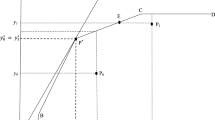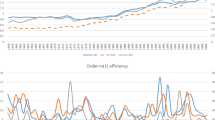Abstract
This paper examines the within-industry distributions of jobs created and destructed across plants in terms of technical efficiency, technical efficiency change, scale effect, and technical change. It further investigates how these distributions vary with economic activity. By applying the stochastic frontier analysis to plant-level longitudinal data on Taiwan’s 23 two-digit manufacturing industries spanning the period 1992–2003, we find that jobs created (destructed) are disproportionately clustered at plants with lower technical efficiency but higher rate of technical change. A fall in economic activities is associated with a statistically significant decrease (increase) in the fraction of newly created (destructed) jobs accounted for by plants with a higher rate of technical change, indicating that creative destruction is more pronounced during economic contractions.
Similar content being viewed by others
Notes
In an earlier version of this paper, we used a production function that restricts the patterns of TE change to be the same for all firms—which is too restrictive for our intended purpose of analyzing the rate of technical efficiency change across plants. We thank the associate editor for pointing this out and suggesting to switch to this more flexible model.
For the derivation of the likelihood function, see Aigner et al. (1977) and Chapter 3 of Kumbhakar and Lovell (2000). The maximum likelihood estimation of the half normal production function is carried out using the computer program Frontier 4.1, written by Professor Tim Coelli. Frontier 4.1 is available at http://www.uq.edu.au/economics/cepa/frontier.htm.
According to Kumbhakar and Lovell (2000), TFP change consists of four as opposed to three terms. Specifically, \( T\dot{F}P = {\text{T}}\Updelta + {\text{SC}} + \sum\nolimits_{k} {\left[ {\left( {\frac{{\varepsilon_{k} }}{\varepsilon }} \right) - S_{k} } \right] + \dot{X}_{k} + {\text{TE}}\Updelta .} \) That is, there should be a fourth term that captures the effect of allocative inefficiency in Eq. (3-3), but because data on the price of capital service are unavailable, we are unable to empirically calculate the allocative inefficiency term. We follow Kumbakhar and Lovell (2000, p. 284) to assume that factors are paid the value of their marginal product, i.e., plants attain allocative efficiency so that the allocative inefficiency term vanishes. We are indebted to the associated editor’s suggestion to include the above discussion about the allocative inefficiency term in this paper.
Note that calculating the output elasticity of capital as one minus labor’s share in output implicitly assumes that the product market is perfectly competitive such that there is no markup. As a result, factor income shares add up to one and the production technology exhibits constant-returns-to-scale.
For an excellent review of the advantages and drawbacks on the index number approach and the SFA approach, see Chapter 12 of Coelli et al. (2005).
The main drawback of the SFA approach is its requirement of specifying a particular functional form for a production or a cost function, despite that the true functional forms are not known a priori.
We are indebted to the associate editor for pointing this out.
The two-digit industry classification codes have been changed twice during the sample period. The four-digit codes are used to retrieve a consistent two-digit industry classification.
The average exchange rate over the period 1993–2003 was NT$30.47/US$1.
For brevity the same statistics for individual industries are not shown but are available upon request.
See Sect. 2.2 for a brief review of the theoretic debate on the effects of downturns on the effectiveness of the restructuring process.
Industry-level real output is calculated by the authors by summing up plant-level real output across plants in an industry.
The mean, standard deviation, minimum, and maximum of real per capita GDP growth over the period 1992–2003 are 5.26, 2.68,–2.17, and 7.85%, respectively.
References
Aghion P, Howitt P (1992) A model of growth through creative destruction. Econometrica 60:323–351
Aigner D, Lovell CAK, Schmidt P (1977) Formulation and estimation of stochastic frontier production function models. J Econ 6:21–37
Barlevy G (2003) Credit market frictions and the allocation of resources over the business cycle. J Monet Econ 50:1795–1818
Bartelsman E, Haltiwanger J, Scarpetta S (2009) Cross country differences in productivity: the role of allocative efficiency. In: Dunne T, Jensen JB, Roberts M (eds) Producer dynamics: new evidence from micro data. NBER/University of Chicago Press, Chicago
Bertin A, Bresnahan T, Raff D (1996) Localized competition and the aggregation of plant-level increasing returns: blast furnaces, 1929–1935. J Polit Econ 104:241–266
Bresnahan T, Raff D (1991) Intra-industry heterogeneity and the great depression: the American motor industry. J Econ Hist 51(2):317–331
Caballero R, Hammour M (1994) The cleansing effect of recessions. Am Econ Rev 84:1350–1368
Caballero R, Hammour M (1996) On the timing and efficiency of creative destruction. Quart J Econ 111:805–852
Caballero R, Hammour M (2005) The cost of recessions revisited: a reverse-liquidationist view. Rev Econ Stud 72:313–341
Cantner U, Krüger J (2008) Micro-heterogeneity and aggregate productivity development in the German manufacturing sector, results from a decomposition exercise. J Evol Econ 18:119–133
Coelli TJ, Prasada Rao DS, O’Donnell CJ, Battese GE (2005) An introduction to efficiency and productivity analysis, 2nd edn. Springer, New York
Davis S, Haltiwanger J, Schuh S (1996) Job creation and destruction. MIT Press, Cambridge
Eslava M, Haltiwanger J, Kugler A, Kugler M (2004) The effects of structural reforms on productivity and profitability enhancing reallocation: evidence from Columbia. J Dev Econ 75:333–371
Eslava M, Haltiwanger J, Kugler A, Kugler M (2010) Factor adjustment after deregulation: panel evidence from Columbian plants. Rev Econ Stat 92(2):378–391
Foster L, Haltiwanger J, Krizan CJ (2001) Aggregate productivity growth: lessons from microeconomic evidence. In: Harper D, Hulten M (eds) New developments in productivity analysis. University of Chicago Press, Chicago
Foster L, Haltiwanger J, Krizan CJ (2006) Market share reallocation, and restructuring in the US retail trade sector in the 1990s. Rev Econ Stat 88(4): 748–758
Foster L, Haltiwanger J, Syverson C (2008) Reallocation, firm turnover, and efficiency: selection on productivity or profitability? Am Econ Rev 98(1):394–425
Good D, Nadiri MI, Sickles R (1997) Index number and factor demand approaches to the estimation of productivity. In: Pesaran MH, Schmidt P (eds) Handbook of applied economics, volume II-Microeconometrics. Basil Blackwell, Oxford, pp 14–80
Hulten C (2009) Growth accounting. NBER Working Paper 15431
Kumbhakar SC, Lovell CAK (2000) Stochastic frontier analysis. Cambridge University press, Cambridge
Mortenson D, Pissarides C (1994) Job creation and destruction in the theory of creative destruction. Rev Econ Stud 61:397–415
Olley S, Pakes A (1996) The dynamics of productivity in the telecommunications equipment industry. Econometrica 64:1263–1297
Ouyang M (2009) The scarring effect of recessions. J Monet Econ 56:184–199
Schumpeter J (1934) The theory of economic development: an inquiry into profits, capital, credit, interest and the business cycle. Harvard University Press, Cambridge
Schumpeter J (1939) Business cycles: a theoretical, historical, and statistical analysis of the capitalist process. McGraw-Hill, New York
Schumpeter J (1942) Capitalism, socialism, and democracy. Harper, New York
Author information
Authors and Affiliations
Corresponding author
Rights and permissions
About this article
Cite this article
Lin, YC., Huang, TH. Creative destruction over the business cycle: a stochastic frontier analysis. J Prod Anal 38, 285–302 (2012). https://doi.org/10.1007/s11123-012-0273-3
Published:
Issue Date:
DOI: https://doi.org/10.1007/s11123-012-0273-3




